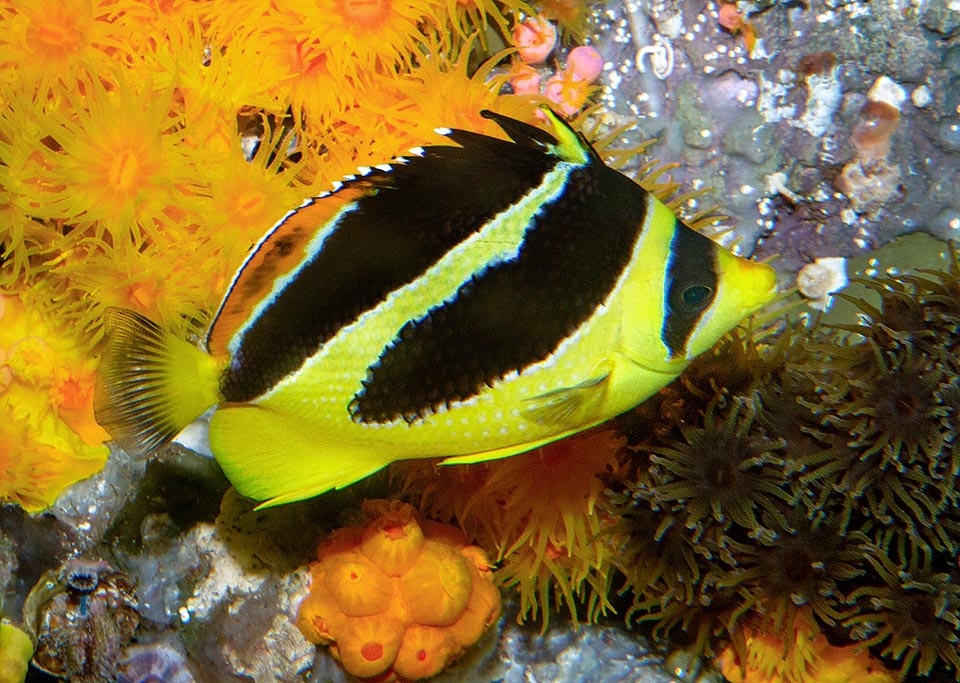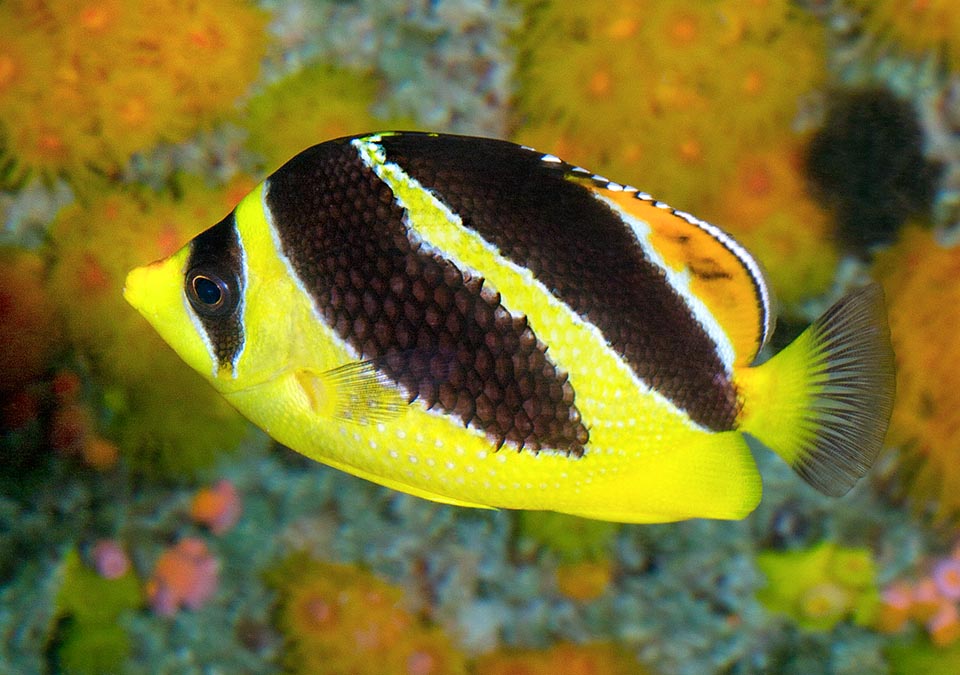Family : Chaetodontidae

Text © Giuseppe Mazza

English translation by Mario Beltramini
The Indian butterflyfish (Chaetodon mitratus Günther, 1860) belongs to the class of the Actinopterygii, the ray-finned fishes, to the order of the Perciformes and to the family of the Chaetodontidae.
The name of the genus Chaetodon comes from the Greek “χαίτη” (khaite) = hair and “ὀδούς” (odous) = tooth, because of the teeth shaped like bristles, whilst tha specific one, mitratus, in Latin with the mitre, with the turban, refers to the dark oblique bands over the head.
Zoogeography
The Chaetodon mitratus is present only in nine sites of the Indian Ocean. We find it along the coasts of Madagascar and adjacent islands of Comoros, Mautitius, Réunion, Seychelles, then proceeding eastwards in the Maldives and Chagos islands, and then finally in the Cocos and Christmas islands.

Present only in 9 sites of the Indian Ocean, the Chaetodon mitratus distinguishes, in the butterfly fishes, due to the more triangular than oval profile and the short snout © Giuseppe Mazza
Ecology-Habitat
It lives in relatively deep waters for a butterfly fish, usually at 50-68 m, where grow, on the outer slopes of the reefs, the gorgonians and the black corals. It can go down up to 80 m and is rarely found over the 40 m with some exceptional ascension to the 22 m.
Morphophysiology
It measures less than 13 cm with a maximum of 16 cm. The body, as normal among the Chaetodon, is laterally flat with the tall back, but here, unlike usual, the profile is more triangular than oval and the snout is short. The mouth is protractile with 6-7 rows of tiny teeth arranged like brushes on both jaws. The background colour is yellow, more intense in the specimens of the Mauritius, with 3 characteristic bands. The first, vertical, camouflages the eye and the other two, wider and oblique, wrap the body, including the first part of the dorsal fin that, when it is really cornered and cannot escape, the fish raises against the enemies, with 8 spiny rays and 18-20 soft, to scare them and to look bigger. The remaining part of the dorsal fin has orange shades and the tiny border is white. All other fins, but the trasnparent pectorals, are yellow. The anal has 3 spiny rays and 14-15 soft; the pectoral and pelvic ones are unarmed; the caudal is more or less truncated.

At the most 13 cm long, lives in relatively deep waters for a Chaetodon. Typical are the 3 dark belts, oblique on the head like a turban © Giuseppe Mazza
Ethology-Reproductive Biology
Chaetodon mitratus nourishes of plankton and small benthic invertebrates. It lives alone or in small groups of 5 individuals at the most. During the reproductive period couples, at times lasting, take form.
The mating takes place while swimming and the eggs, fecundated on the flight by the male, are entrusted to the currents. They hatch on the following day. The pelagic larvae go drifting for about 2 months and the small fishes reach often the bottoms very far away from the place where they were born. Once reached a certain size, the juvenile livery is practically the same as the adults one.
It is a relatively long-lived species, sold at high price for the aquarium life. The populations can double in less than 15 months and the fishing vulnerability index is very low, marking only 10 on a scale of 100.
Since 2009 Chaetodon mitratus has therefore been listed as “LC, Least Concern” in the IUCN Red List of endangered species.
Synonyms
Tetragonoptrus mitratus (Günther, 1860).
→ For general information about FISH please click here.
→ For general information about BONY FISH please click here
→ For general information about CARTILAGINOUS FISH please click here.
→ To appreciate the BIODIVERSITY of BONY FISH please click here.
→ To appreciate the BIODIVERSITY of CARTILAGINOUS FISH please click here.
